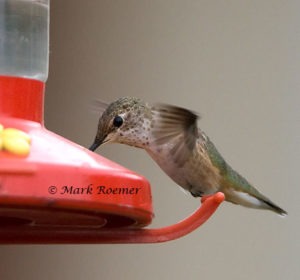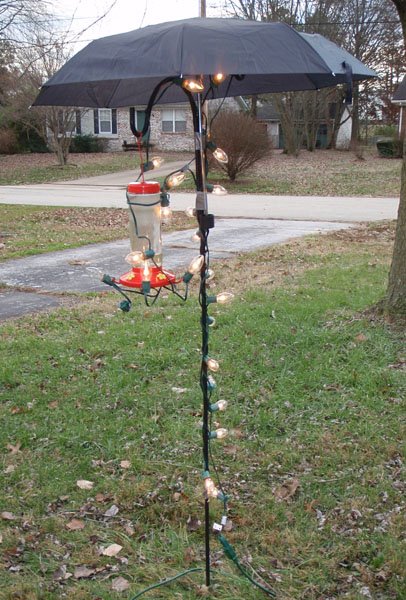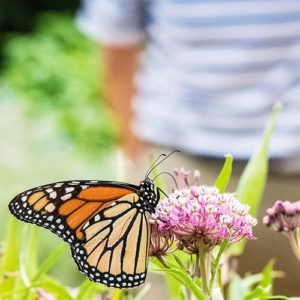It was one of those perfect late fall days. You know – the ones where you throw the windows open to enjoy some of the last warm weather of the year. I was sitting at one end of the couch reading, while Anthony sat at the other end watching a football game.
Suddenly, we both looked up with the same question reflected on our faces. It sounded like there was a hummingbird right outside the window! But it couldn’t be. We hadn’t seen a hummingbird in weeks. I would have been tempted to think I was imagining things, except the look on Anthony’s face said he was hearing and thinking the same thing.
Slowly we turned to look. Hovering in front of the window and checking out our red curtains as if they were giant red flowers was a hummingbird! And with that we entered the world of winter hummingbirds in the eastern U.S. It was something that we’d heard of but never dreamed we’d be lucky enough to experience ourselves.
We immediately put our hummingbird feeder back up and contacted the appropriate local experts. Our bird was eventually identified as an immature female rufus hummingbird – a species that is much more common in the West than here in the eastern U.S. We also worked with the local experts to have her caught and banded so that her information could help scientists better understand this uncommon phenomenon.
She continued to visit our feeder throughout the winter, before disappearing in March presumably to head north to the breeding grounds. We moved the following fall so don’t know if she returned, and we haven’t been lucky enough to have another one show up where we live now. But every year, I keep my eyes open in October and November hoping that we’ll get lucky again.
I occasionally get asked about winter hummingbirds by someone who is lucky enough to have one show up at their house. So, I thought I’d use this blog article to answer some common questions, including how to care for winter hummingbirds if one does show up for you.

What are winter hummingbirds?
“Winter hummingbirds” is a catch-all term for the relatively rare hummingbirds that overwinter in the eastern U.S. They could potentially be one of several species of western hummingbirds, although the rufus hummingbird is the most common species to overwinter in the eastern U.S.
There have probably always been a few winter hummingbirds in the eastern U.S., but no one really noticed them out in the wild. Then as putting up hummingbird feeders became more popular over the last 40 years or so, people who forgot to bring their feeders in began occasionally noticing them.
At first scientists thought that those birds had to be lost or confused. However, we’ve discovered that’s not true. In fact, it’s not uncommon for a winter hummingbird to return to the same, or very close to the same, location for multiple winters in a row.
There’s still a lot to learn about winter hummingbirds, but one of the suggested reasons for why these birds choose to spend the winter in the eastern U.S. instead of heading to Central or South America like most members of their species is because it puts them that much closer to the breeding grounds in the spring. Basically, it’s a gamble. Can they survive the harsher winters of the eastern U.S. in order to gain the benefits of being one of the first ones to arrive on the breeding grounds?
How common are winter hummingbirds?
It’s hard to answer this question, because scientists only know about the ones that are seen and reported. Obviously, not all of them are going to be seen and not everyone who sees a winter hummingbird will report it.
According to Brainard Palmer-Ball, an expert hummingbird bander and retired zoologist from the Office of Kentucky Nature Preserves, every year Kentucky may have anywhere between one and maybe a dozen or so winter hummingbirds reported. Yet, along the Gulf Coast, someone may have as many as a dozen in their yard if they are especially lucky.
It stands to reason that to some degree, your chances of finding a winter hummingbird depends on where you live, with winter hummingbirds being much more common in more southern states than in more northern states. Regardless, they are still fairly rare compared to the numbers of ruby-throated hummingbirds that can be found in an area during the breeding season. Most people will probably never see one.
How far north can hummingbirds be found in the winter?
I know of a rufus hummingbird that spent pretty much the entire winter in Connecticut a few years ago. It disappeared in February, but by then it could have started its migration back to the breeding ground. I’ve also heard of one that spent at least part of the winter in Michigan. On that one, I’m not sure how far north it was in Michigan or how long it was observed.
Sometimes winter hummingbirds that are first observed in more northern climates early in the winter will be found further south later in the winter. (We know that it was the same bird because it was captured and banded in the North, then recaptured later in the winter several states further south.) So, most of the eastern U.S. is a possibility for winter hummingbirds for at least part of the winter. Although they are going to be much less common the further north you go.
What do they eat?
There might not be many flowers blooming in the winter but remember that 80% or more of a hummingbird’s diet is insects. And although we always think about the winter as being “bug free,” that’s not actually true, especially around the latitude of Kentucky and below. Once you start looking, there are quite a few insects active on warmer days during the winter.
So, hummingbirds can catch and eat insects like normal during the warmer days. According to Palmer-Ball, winter hummingbirds will also visit sapsucker holes to pick out insects and get carbohydrates from the sap. Then of course, they’ll make full use of any feeders they find available.
What should you do if you find a winter hummingbird?
1) Tell the appropriate experts
If you happen to have a winter hummingbird show up, then I highly recommend you report it so that your sighting can help scientists better understand this interesting phenomenon. When you report it, you’ll likely be asked if you want to have the bird banded.
Only specially trained experts are allowed to capture and band hummingbirds. Banding a hummingbird involves putting a small bracelet (the band) on the bird’s leg. The band will have a unique number which is entered into a national database so that if the bird is captured again it will be able to be identified and researchers will know where else it has been captured at.
Having your bird banded is always optional. No one is going to pressure you to do it or come on your property uninvited to try to catch and band the bird. However, I would encourage you to do it so that researchers can continue to learn more about your bird and its behaviors.
The easiest way to find out who to contact if you find a winter hummingbird is by going to the Southeastern Avian Research center’s website. They have a list of hummingbird banders in many states throughout the eastern U.S. If your state isn’t listed, you can also email Cyndi Routledge, founder of Southeastern Avian Research, and she’ll help you find a local contact. Her email address is on the same page as the list of hummingbird banders.

Decide whether to feed it
If you want to commit to feeding the bird for as long as it needs it, then you can put your hummingbird feeder back up and leave it up. The later in the season it is and the colder the temperatures become, the more important that feeder becomes because your winter hummingbird is going to have a lot fewer alternative food sources than your summer hummingbirds have.
So, Palmer-Ball suggests being sure that you want to commit to feeding the bird throughout the winter before putting a feeder back up for any length of time. (If you’re trying to get it banded, then you may be asked to put a feeder up until it’s been captured.)
When we hosted our winter hummingbird, our neighbors thought we were insane. I raided Mom’s attic and pulled out some of the old Christmas lights – the big ones that got hot if you left them plugged in – and strung them up a shepherd’s pole and our hummingbird feeder to help keep the food from freezing. I also attached an umbrella above the feeder to try to give it a little more shelter from any precipitation while it was feeding.
On the coldest nights I would bring the feeder in after dark, then wake up before dawn to put it back out again. Nowadays, there are heated feeders that you can get which are designed to keep the sugar water from freezing.
However, don’t freak out if you see your bird sitting on a perch (or possibly even hanging from one leg) looking like it’s dead. Hummingbirds naturally go into a form of short-term hibernation called torpor when the temperatures drop. Their body temperature, heart rate, and breathing all drop WAAAYY down to almost nothing relative to “normal.” This behavior allows them to conserve energy when they can’t feed.
Leave them alone and they’ll naturally come out of torpor when the conditions are right. Please don’t try to warm them up or anything like that because it will likely kill them. Even if they initially fly off, they may not be able to find food or sustain themselves afterwards. So, this is one of those cases where trying to “help” is actually doing the exact opposite, and I know that’s the last thing you want to do.

Summary
Winter hummingbirds are relatively rare but can be exciting guests if you’re lucky enough to have one show up. Scientists also still have much to learn about these hummingbirds and their behaviors. So, it’s always important to at least let the appropriate local experts know that your bird exists even if you choose not to have it banded.
If you would like personalized help creating your own pollinator and wildlife habitat, then we encourage you to check out the Backyard Ecology™ Community.
There’s lots of great “big picture” information available about creating pollinator gardens or larger habitats for pollinators and wildlife. What’s lacking are opportunities to say, “This is what I want to do. This is what I’m struggling with. How do I make it work on my property?”
That’s part of what the Backyard Ecology™ Community offers its members every day.

Thank you!
These amazing individuals go above and beyond every month to provide financial support which helps us create so much free content for everyone to enjoy and learn from.
Julie Krygier, Lizabeth, Russel Furnari, Crystal Robinson, Karen Veleta, Kevin B, Sally Mirick, Crystal Dyamonds, Mitchell Bell, Laura Hunt, Sue Ann Barnes, Adrienne Richardson, J. Adam Perkey, Ariel, Cara Flinn, David Todd, LaVonne Fitts, Cathy, Michael, Tom Winner, Eric Fleming, Julie, SB H, Christopher Scully, Craig, Rachel Antonucci, Melissa Egbertson, Switzy, CotswoldsCottageMA, Vilma Fabre, Pia O Nomata, Linda McNees, HerculesBiggerCousin, Patrick Dwyer, Paul Gourley, Lilith Jones, John Master, William Morin, Lori Sadie Ann, Debra, Ayn Zitzman, Han Mad, Isaac Kowis, Cathy Anderson, Betsy Lessels, Reid, and Dave Teare.
Backyard Ecology™: Creating thriving backyard ecosystems that you can enjoy and be proud of
We created Backyard Ecology™ to help you confidently create pollinator and wildlife habitat that you can enjoy and be proud of. Because nature isn’t just “out there.” It’s all around us, including right outside our doors.
Our focus on the eastern U.S. means that the information we share is applicable to you and where you live. Join us as we ignite our curiosity and natural wonder, explore our yards and communities, and improve our local pollinator and wildlife habitat.

Backyard Ecology™’s Guiding Principles:
🦋 Curiosity: Nature is fun, interesting, and worth exploring. We will never know everything. Answers lead to more questions. That’s half the fun.
🦋 Balanced: You don’t have to choose. You can support nature AND have a beautiful property that you can enjoy and be proud of.
🦋 Science informed: Habitat creation and management should be based on the latest scientific research available. This is true regardless of whether you’re working in a small garden or on hundreds of acres.
🦋 Stewardship: Anyone can make a positive difference in the natural world and leave an ecological legacy on their property.

Leave a Reply